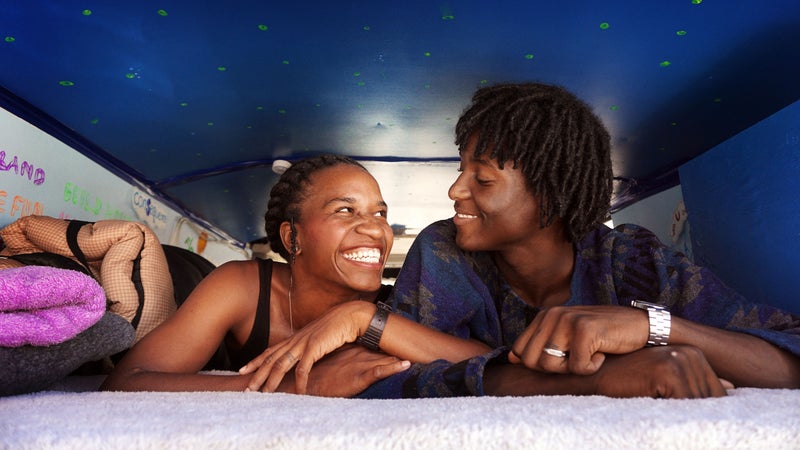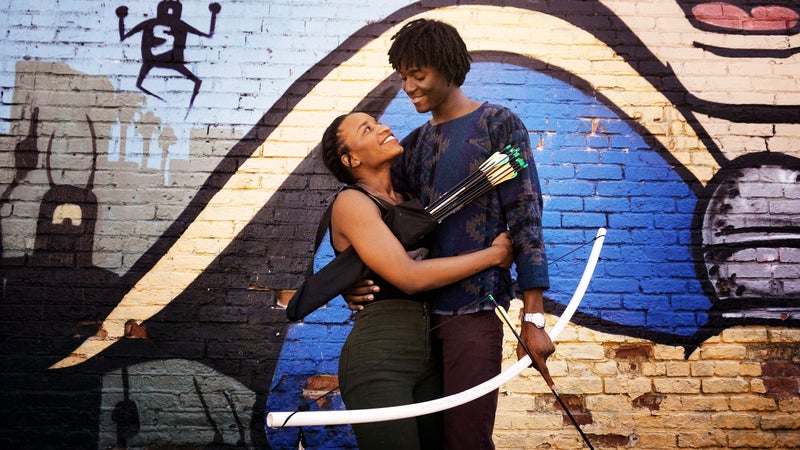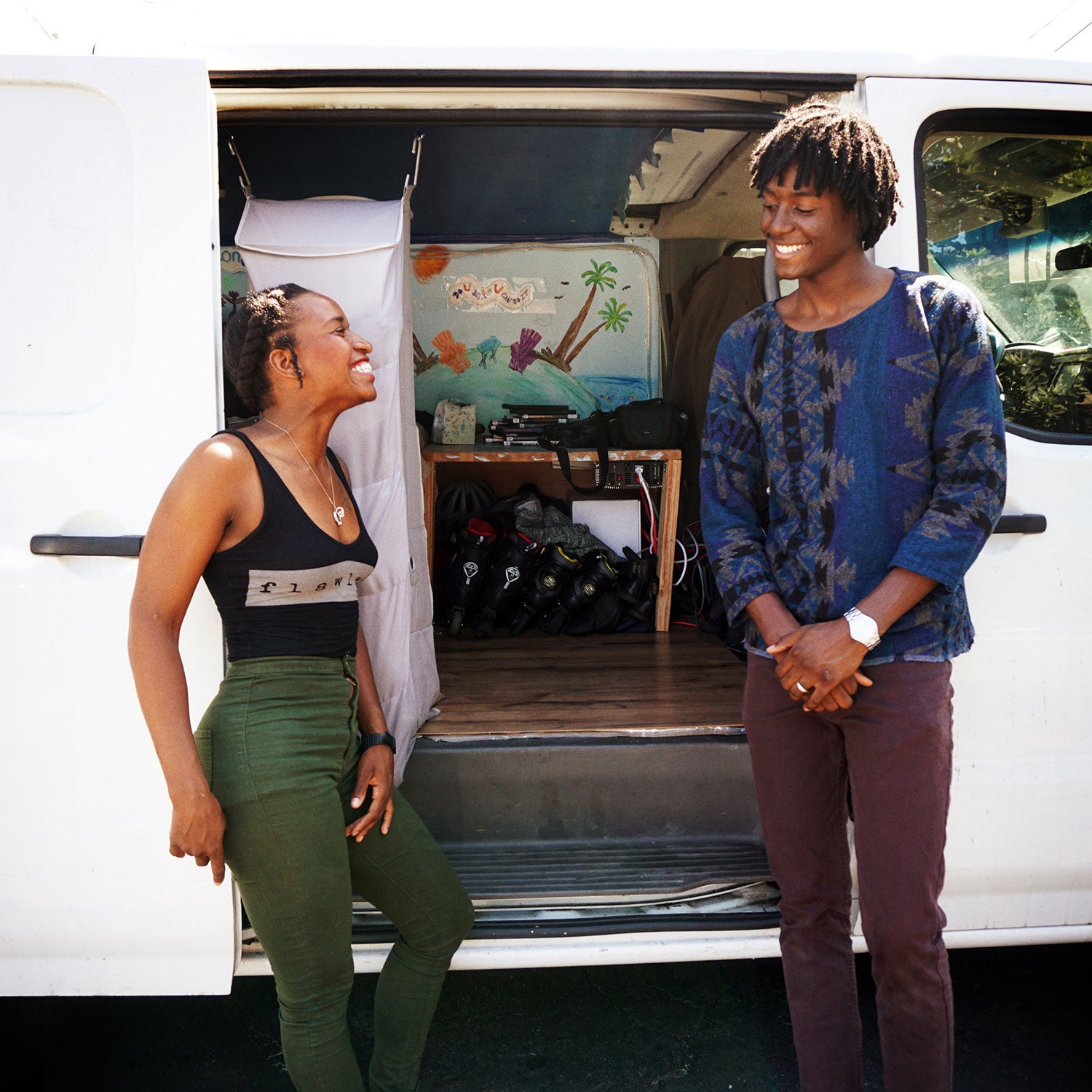I’m slouched in the back of Paris and Lovell Lee’s live-in Nissan cargo van, which is parked behind a colorful Cuban coffee shop in L.A.’s Silver Lake neighborhood. The full-time college students are visiting from San Francisco for the weekend, and they’re stoked for the opportunity to show off their home. Paris, 24, has already unearthed an ax, inline skates, a fishing rod, and a sewing machine from its cramped quarters. Then her eyes light up. “Oh, I have to show you �ٳ�,” she says, rooting around behind their bed to produce��a��quiver of arrows and a bow that after watching a YouTube tutorial. I ask what inspired this PVC-meets-Robin-Hood creation. Paris slips the nock of an arrow onto the bow’s taut cord and lifts it up. She lets the tension hang for a moment, then deadpans, “Because we need protection.” After another pause and a smirking headshake from Lovell,��she drops the bow and dissolves into peals of��laughter. “I mean, what if we see a ����?”
The Lees grew up in vastly different parts of the country (Paris is a native Chicagoan; Lovell was born in Mobile, Alabama), met in the Navy in 2013, and later chose to begin their post-military lives together in L.A., where Paris had wanted to live since the sixth grade.��
They planned to enroll at the Academy of Art University in San Francisco, where Paris wanted to study directing and screenwriting and Lovell planned to pursue��fashion and design. But they also craved mobility. While lounging in their apartment complex hot tub one night before heading north, an idea struck. Lovell owned a van, initially intended to serve as a mobile IT workshop, and the two had thrown an air mattress inside for a few brief road trips in the past. What if they could live in it full time?
They weren’t looking to hop on the #vanlife bandwagon when they moved into their rig last spring; the couple simply wanted to save money and explore a different way of living. “I had no clue,” Paris says. “I thought we were going to be the first ones to ever do it.”��Lovell devoured��instructional videos and worked up a simple build. Due to a misunderstanding with their lease, the two rushed��to vacate their apartment, filling the van with their belongings. Lovell says of their first official night as full-time nomads,��“We didn’t even have room to sleep on the bed!”
If you search for online, the results��tumble forth in a somewhat predictable parade of aspirational imagery: back-door sunsets, Pendleton-wrapped��couples enjoying morning coffees, gently worn prayer flags, adorable adventure pups. And white people. A lot of white people. Narrow the��search to��#blackvanlife, however, and the results are nearly nonexistent.��The Lees are part of a growing community that’s slowly but surely changing the��dynamic with a��movement that’s less about hashtags and Instagram filters than it is about saying “we’re here too”��and sharing the less-than-Instagrammable side of van dwelling.

Every single van-lifer I spoke with said that they��knew of no such community when they started out.��When she first considered moving into her SUV, New Jersey–based personal trainer and photographer Mia Sommers��wanted to explore the stories of other black people who were experimenting with mobile living. “I really couldn’t find anybody,” she recalls. “And I’m like, Gosh, why are we so afraid? Where are �ɱ�?”
Los Angeles musician Christopher Watson, 28,��spent ten weeks this past summer traveling around the country in a refurbished RV as part of the, a music and filmmaking project. Unsurprisingly, the majority of other nomads he met were white, an experience reflected in most media coverage of the trend—you didn’t even have to move past the title of the popular April��New Yorker piece “#Vanlife, the Bohemian Social-Media Movement” to understand exactly who its subjects would be. To many people, however, the perfectly composed Instagram images and glamorization of mobile dwelling are to be taken with a grain of salt. (“I see a fairytale,” Lovell says.)��After all, not so long ago,��#vanlife was just, well,��#livinginavan. Watson posits that black parents often project cautiousness to their children when it comes to pursuing lifestyles that seem to lack stability, but also points to cultural norms as enhancing the disparity. “For certain activities, it’ll be later for black people to one, be keen on it, and two, be portrayed as people who can do it or who can afford that kind of lifestyle,” he explains. “I’m not saying that white people are more adventurous, but I think that’s just the way it is at the moment.”
When she first considered moving into her SUV, Sommers wanted to explore the stories of other black people experimenting with mobile living. “I really couldn’t find anybody,” she recalls. “And I’m like, Gosh, why are we so afraid? Where are �ɱ�?”
Crystal Vanner, a 46-year-old creative freelancer from Virginia who lives full-time in a 1996 Mercury Villager dubbed Not Your Momma’s Van,��is more explicit. “You look at the news… We are not welcomed everywhere in this country,” she says. “I hear horror stories of people being harassed at rest stops or being watched, so it can be scary, especially as a single woman, let alone a single black woman.”
Vanner is relatively new to nomadic living, hitting the road full-time in August.��But like Sommers (whose YouTube channel, , has more than��3,400 subscribers), she’s also become a . Vanner��was initially drawn to van dwelling as a step toward living in a tiny house.��“I knew that paying rent in northern Virginia was not going to allow me to save any money for a tiny house, so when YouTube recommendations popped up with van dwelling [videos], I went down that rabbit hole.” It dawned on Vanner that she could not only save money, but also travel around the country if she ditched a traditional “sticks and bricks” home and moved into the van she already owned.��
Vanner began vlogging��in 2015, and she’s met several subscribers (“Vanner��fanners”)��throughout her travels. “A lot of them are black women and they’re like, ‘You are my role model,’ or ‘I know I can do this because I watch you do it,’ and it’s really humbling,” she says. “When I started, I didn’t see people like me, and now they have someone.”
In May, the Lees began documenting their new life, posting videos to YouTube under the name Novel Kulture. The couple are hilarious and sweet in person and on camera, but they’re also��real about��the messiness of van life. Their videos show not just daily vlogs��(“”) but��explainers on the finer��points of van dwelling��(“”) and dispatches from some of their rougher times on the road:��they ripped out their entire original build, lost their rooftop solar panels on the highway, racked up numerous parking tickets, and even had their van towed from beneath a confusing jumble of San Francisco street signs.
An experience in rural Nevada, however, marked a particular low point. While returning from a cross-country trip, they encountered��an accident scene.��As they approached the area, a man who was helping direct traffic motioned for them to slow down, then��hurled a heavy safety cone at their windshield, severely cracking the glass. (They posted a showing the damage.)��Lovell sought help from nearby Nevada Highway Patrol officers, but felt frustrated after the officers insisted��they couldn’t intervene without video of the actual incident. “I told Lovell that I didn’t want to travel the United States any more after that happened,” recalls Paris. “I was just like, I don’t feel safe.” Lovell is pensive. “That’s not going to stop me from doing stuff, but I don’t want to be somebody’s target.”��

They’ve experienced some low points as vloggers, too. “We had to really dig” when searching for other black van-lifers, Paris says. Realizing that their own channel might serve as a homing beacon for others, the Lees included the phrase Black Van Life��in their first few video titles. Despite receiving overwhelming support, they also fell victim to an assortment of negative, often overtly racist commentary. Lovell took the high road, offering patient explanations for why they included the phrase, but became exhausted and eventually removed it from every video.
Still, the Lees have mostly good things to say about their experience.��They are��floored by the community they’ve found, both online and in real life. Their YouTube following is small (almost 2,000 as of publication) but loyal. Still, they seem genuinely shocked that what began as a personal documentary ended up as a point of reflection and inspiration for others considering similar journeys.��“We had one comment [where] a woman was like, ‘I didn’t know there were black people doing this, and I didn’t know if I would be accepted.’ And I was like, Why does she feel like she wouldn’t be accepted? It doesn’t matter—just live your life,” says Paris. “I just want to show black people, like, look—just go out and have �ڳܲ�.”
Other van dwellers echo the sentiment.��Sommers is��saving money for future travels and no longer has to deal with unpleasant neighbors or difficult landlords; instead, the world feels wide open. “I would love to see more people of color coming out of these apartments that many of us don’t own, moving into some type of mobile house, car, or SUV, and stop spending so much money for everybody else to be wealthy,” she says.��Vanner��hopes to extend her explorations to Canada and South America. “Freedom, that’s the main advantage,” she says. “Wherever you have an inkling to go, you just go.”
Living in their van��hasn’t yet provided financial stability, but the Lees say it’s helped them in many other ways. They’ve pared their belongings to the essentials. They have the mobility and flexibility they dreamed of. They’re��inspired to dig deeper into their respective passions. And without television as a distraction, they have adopted a slew of new hobbies��(including archery). If living in such close quarters has done anything but strengthen their relationship, there’s no sign. “I have to remind myself of why we’re here,” Lovell says, slipping an arm around his best friend.��“Because it’s all about me and her.”


